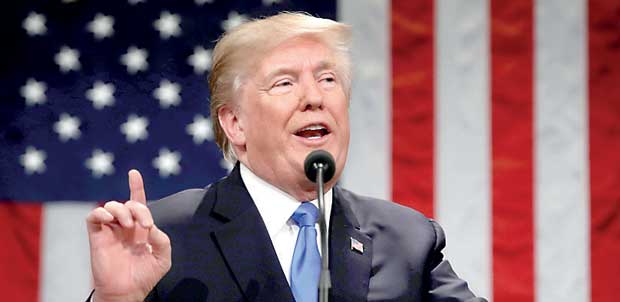09 Feb 2018 - {{hitsCtrl.values.hits}}

 This week’s State of the Union (SOTU) address by American President Donald J. Trump offers instructive lessons on CEO communication.
This week’s State of the Union (SOTU) address by American President Donald J. Trump offers instructive lessons on CEO communication.
Immediately after his address, Trump’s job approval rating shot up from 32 percent to 42 percent (CNN). His detractors will be quick to point out that his tweets will bring down this figure in no time.
In his address, Trump had to accomplish at least three goals: fire his base to come out and vote at the mid-term elections in November – globally, parties in power tend to lose mid-term elections; soften his rival party lawmakers (Democrats) to support his agenda – at least in part and unite the country after his divisive rhetoric over the past two years.
Through a careful analysis of his speech, I will attempt to arrive at a conclusion whether or not Trump achieved these three communication objectives.
Responding to stakeholders
Trump usually pitches to his base – the affluent, xenophobic and ‘losers of globalisation’ (let’s call them ‘LOGLOs’: Americans whose jobs have been exported overseas or taken over by foreigners at home). He did not let these three groups down.
He commented on his tax cut, which mostly benefits the affluent – according to some reports, the top one percent gets 83 percent of the tax benefit. He also articulated tough immigration policies and fair trade deals that would delight the xenophobic and LOGLOs.
Therefore, Trump has no doubt helped his Republican lawmakers to sell these policies and accomplishments in their home constituencies and thereby win votes in November. Since Trump spoke mainly to his base, it remains to be seen how the rest of the US electorate would respond to him in the weeks and months ahead – especially since most Americans are not wealthy, xenophobic or LOGLOs.
Appealing to emotions
Trump succeeded in appealing to both ‘sublime’ emotions as well as ‘base’ emotions of human beings through effective storytelling. For example, by showcasing the humanity and generosity of a police officer who adopted the child of a female drug addict, he showed the Americans’ exemplary human values.
On the other hand, Trump appealed to the Americans’ fear or dark side by scaring them with a story of how children of illegal immigrants killed two teenage girls. However, it is creditable that most of Trump’s stories appealed to the ‘higher angels’ of Americans.
Adding value to stakeholders
Audiences expect leaders to add value to their lives. This is done through sharing of knowledge, insights and experience.
In the SOTU, Trump referred to tax cuts, new job growth, low unemployment rates, return of some manufacturing jobs to the US, modernising infrastructure and renegotiating trade deals, as some of his value additions to his stakeholders.
However, there were no ‘new’ announcements that would benefit ‘rank and file’ Americans: this was a lost opportunity for Trump.
Instilling confidence in leader
Leaders’ speeches must inspire confidence in their leadership and ability to realize their vision. Trump alluded to his actions to deregulate industries and repeal of Obamacare as examples of his leadership. It must be noted that these actions are – at best – controversial to most Americans. Therefore, these statements might further fragment, not unite, the American people.
Dealing out optimism
Leaders are dealers in optimism: optimism about their organisations, optimism about their people and optimism about their collective future. Although Trump’s speech started and ended on a positive note, the address lacked optimism. He seemed to be bored to be there. This lack of optimism was accentuated by his sombre tone.
Articulating core values
CEOs are chief expressive officers of organisational values. Like most past US presidents, Trump too articulated some of the core values of the US: dreaming, hard work, achievement, etc. However, since some of his personal values are anathema to some Americans, Trump was wise to stick to the values that most Americans can agree with.
Staying on message
Staying on message is a critical skill in CEO communication. Trump is notorious for his ‘off the cuff’ comments and controversial tweets. However, in the SOTU address, Trump stuck to his script on the teleprompter. His staff must have been relieved that he did this.
On a more serious note, this shows why it is very important for CEOs to read off a script when they are announcing something very important, serious, difficult, divisive or controversial. This eliminates or minimises gaffes that can hurt a CEO’s cause.
Body language and controlling nervousness
Body language never lies. Trump’s body language indicated that he was not very comfortable delivering the SOTU via teleprompter – he is at his “most comfortable best” speaking off the cuff: the thing that also lands him in controversy. This was indicated by his continuous pacing back and forth behind the lectern and standing some distance away from the lectern. However, he did well in giving credit to lawmakers by pointing at them to acknowledge their role.
Applause
Leaders are supposed to lead the applause or acknowledge applause. By the same token, leaders are not expected to clap for themselves: this happened many times in the SOTU, where Trump applauded himself or his achievements.
This behaviour might confirm the view of his detractors that Trump is a narcissist. Some of the people Trump recognised knew better than the US president: when recognized, they waived or bowed and acknowledged the applause – which is the correct response.
In closing, given the analysis above, we may conclude that through his SOTU address, Trump achieved the first goal: fire his base. However, he failed to achieve the two other communication objectives: get rival lawmakers on to his side (most Democrats did not clap most of the time) and unite the deeply divided American population.
More importantly, I hope this analysis helped you get a better understanding of the building blocks of CEO communication.
(Yukthi K. Gunasekera is a specialist in CEO communication. He is a linguist with fluency in English, German and Sinhala, with a basic competency in French. He is a US-educated lawyer who also holds a postgraduate diploma in marketing from the Chartered Institute of Marketing, UK. Encompassing over 10 years of experience in corporate communication at IBM Sri Lanka and John Keells Holdings, his mission is to enable people to live rewarding lives through his proprietary training method ‘Communicate By Objective (CBO)’. He welcomes reader comments to this article – [email protected])
10 Jan 2025 1 hours ago
10 Jan 2025 1 hours ago
10 Jan 2025 2 hours ago
10 Jan 2025 3 hours ago
10 Jan 2025 3 hours ago